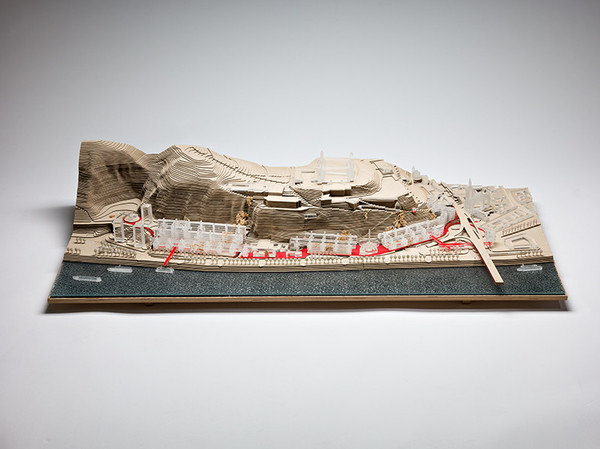As part of the exhibition cycle In the Shop Display, we follow up on the theme of Bratislava's Castle Hill district by presenting an architectural model of Ivan Matušík's, one of Slovakia's leading architects of the late Modernism, vision for the future of this locale. The model was donated to the collections of the Slovak National Gallery as a part of a larger set of fifteen scale models.
Ever since the competition for the university campus in the 1940s, the architects have been more or less intensively trying to solve the new look of the Danube embankment under Bratislava's Castle Hill. In the meantime, the future face of the Castle Hill district should be determined by several internal (among creative teams of former project institutes) and large international competitions.
Architect Ivan Matušík worked on the architectural design of the site twice. For the first time in 1972, when he and his colleagues from the State Project Institute of Commerce (Ján Bahna, Pavel Čížek, Fedor Minárik) took part in a limited architectural competition for the parliament building. Thirty years later, in 2002, a private landowner announced an urban and architectural design competition, in which Ivan Matušík's and Sebastián Nagy's design, named Cukermandel [1], received the highest award.
The area in question stretched from the foot of the Castle Hill up to the waterfront artery, between the bridgehead of the New Bridge in the east and three 1960s high-rise residential towers in the west.
Despite the neglect that has plagued this area since the construction of the bridge over the Danube and the simultaneous removal of historical buildings, both investors and architects were able to sense the potential of the place as a representative, modern multifunctional district close to the Danube promenade.
Nonetheless, in the winning concept, one can notice the effort to combine modern architecture with the genius loci of the area, as well as not to interfere disproportionately with the visual impact of the castle monument. This was, after all, highlighted by the competition jury. Its members appreciated the "continuous horizontal character [of the proposed structure], which forms a suitable base for the Castle massif". [2]
The authors divided the new development into three sectors. With great sensitivity, their design included a layer of preserved remains of Cukermandel's historical buildings and the Water Tower, giving it a new function - a music pavilion. The proposed neighbourhood would not lack any modern-day conveniences - housing, retail facilities, services, culture, office space and recreation. It would connect with the transport network, providing collision-free pedestrian, bicycle and car access.
In urbanism, architecture, construction and layout, the architects chose five squares measuring 10.8 × 10.8 m each, grouped into a cross-shaped structure, as their fundamental compositional element. With its help, they created a mass that offers a dynamic expression for pedestrians passing through its inner longitudinal axis. Still, when viewed from a greater distance, as a whole, it gives a calm horizontal impression. An attribute appreciated by the jury.
According to the authors, the variety of shapes and colours should remind us of the diversity of buildings past. Still, the genius loci in their understanding was expressed beyond this building-historical layer. The rocky character of the castle hill, the mighty river, the lush greenery in the immediate vicinity, the sun and the air/wind found their reminiscences in the green residential terraces, in the use of Danube gravel covering the flat roofs, or in the glass canopies over the most attractive spaces.
[1] Collaborators: Michal Kurina, Zuzana Hlinková, Miriam Šebianová, Ján Bustín.
[2] Opinion on Competition Proposal no. 2 - keyword 'Cukermandel'. In: Urbanisticko-architektická súťaž Bratislava-Podhradie 2002. Self-published by Ivan Matušík, p. 8.
Ivan Matušík (1930 – 2022)In 1953, he graduated from the Faculty of Architecture and Civil Engineering of the Slovak University of Technology and received his master's degree in architecture (Ing. arch.). Between 1954 and 1956, he worked briefly in the studio of professor Ján Svetlík and at the Military Project Institute in Bratislava. From 1958 to 1961, he worked as a head designer at the Stavoprojekt in Bratislava, later (1961 - 1967) as a head designer at the Bratislava branch of the State Project Institute of Commerce Brno (ŠPÚO). He spent the most extended period of his professional life as the director of the Bratislava studio of ŠPÚO, which he ran for thirty years (1968 - 1989). He remained active even after retirement; designs and realised projects from this period won him several awards in architectural competitions, exhibitions and showcases.
The exhibition cycle In the Shop Display enters the public space through the window of Café Berlinka on the ground floor of the Esterházy Palace, presenting works of visual art responding to the issues of contemporary life. In this exhibition format, we have revived collaboration between Peter Bartoš and Július Koller, who in 1968 exhibited their works in a storefront of a stocking repair shop in Klobučnícka Street in Bratislava under the title Interpretation (Anti-gallery).
